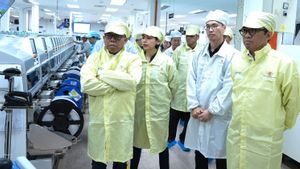YOGYAKARTA - When asked what marginal cost Alias is, the answer is extra costs to create an additional unit.
Marginal costs are costs incurred when Friends of OCBC NISP need to increase manufacturing costs due to extra demand.
In the scope of production costs, the cost margin functions as one of the keys to optimizing profits and avoiding losses.
The reason is that marginal costs help entrepreneurs to find out the target output needed to reach the point of profit from the beginning of manufacture.
To identify more about the method of calculating marginal costs and examples, read more in the following explanation.
The marginal / marginal cost is the cost that arises in the manufacturing process due to the addition of goods or services.
For example, someone who owns a business generally requires a production fee of one million for 5 clothes.
Well, in fact there is an increase in demand by 10 clothes. To be able to generate the unit bonus, the owner of the business needs to add a fee of one hundred thousand. Well, this bonus fee is called the marginal cost.
Because the amount is changing, until this payment is usually reduced from variable costs along with changing output so that there is no fixed cost bonus when producing extra units.
Cost marginal function
As mentioned earlier, the marginal cost helps business owners know the target output to reach the profit point. The trick is to equalize marginal income to the marginal fee.
If the generated marginal income is the same as the marginal fee, the resulting output can optimize profits.
However, if the generated marginal income is smaller than the marginal fee, then production must be increased in order to optimize profits.
On the other hand, if the generated marginal income is greater than the marginal fee, then production can be reduced to optimize profits.
This calculation helps business owners in decision making and business planning so that they can optimize profit.
Examples of Marginal Fees
Examples of marginal costs can be seen from the manufacturing process. For example, someone who owns a dry cake business produces thirty cake jars each day with the help of 4 employees and 3 machines. Something day, when it comes to Eid, the demand for cakes immediately increases by 67 jars.
In order to comply with market demand and speed up the manufacturing process, the owner of the business can raise 2 new employees and one more machine. Even so, the kitchen room used does not need to be expanded.
Why doesn't the kitchen need to be expanded while machines and employees are added? The answer is that the kitchen is part of fixed costs or fixed payments, on the contrary, the number of employees and machines is listed in marginal payments.
As mentioned earlier, if in order to optimize profits, the fee still does not change even though there is a change in output. This is because the additional cost is reduced from the variety cost of production, such as raw material costs and so on.
Methods For Calculating Marginal Fees
Because marginal costs are the necessary costs to create extra units, the method of calculating it can be tried with these 3 sessions.
1. Determine Changes to the Number of Products
The first step in calculating marginal costs is to recognize changes in the number of products after the extra demand.
2. Calculate Cost Change
After recognizing the change in the number of productions, the next stage is to calculate the marginal costs, namely recognizing the total cost difference.
To find out, you can reduce the total budget for old manufactures to new ones. The difference obtained is like the total value of the change in manufacturing pay.
VOIR éGALEMENT:
3. Calculate Marginal Cost
Well, after knowing the total change in product quantities and costs, the next step in determining marginal payments is to divide the two. The following is a marginal payment formula that can be used.
MC= TC/Q
MC = Marginal cost (marginal financing)
TC = Total Cost (change in total production costs)
Q = Quantities (change in product number)
For example, for example, the total production cost of 10 pieces of clothing is IDR 5,000,000. However, after there was an additional demand to 15 pieces, the total cost changed to IDR 7,000,000 due to an increase in raw material costs and a workforce cost of IDR 2,000,000.
From this case, we can calculate the marginal cost by way
MC = (Rp7,000,000-Rp5,000,000) / (15-10)
MC = IDR 400,000
In conclusion, the optimal production cost so that the entrepreneur gets a profit is IDR 400,000.
For example, for example, the total fee for making 10 pieces of clothing is IDR 5.000.000. However, after the request bonus is 15 pieces, the total payment changes to IDR 7.000.000 because of the increase in the raw material budget and the workforce cost of IDR 2,000,000.
So after knowing what a marginal cost is, see other interesting news on VOI, it's time to revolutionize news!
The English, Chinese, Japanese, Arabic, and French versions are automatically generated by the AI. So there may still be inaccuracies in translating, please always see Indonesian as our main language. (system supported by DigitalSiber.id)
















